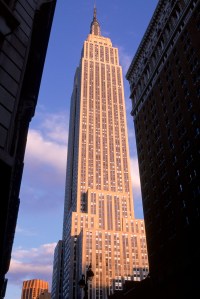 The New York Times reported that on April 30, 1930, “the roar of the riveting machines” fastening together the steel skeleton of the 1,250-foot Empire State Building were silenced so former New York governor and president of Empire State Inc. Al Smith could address retailers gathered at the James McCreery and Co. Department Store.
The New York Times reported that on April 30, 1930, “the roar of the riveting machines” fastening together the steel skeleton of the 1,250-foot Empire State Building were silenced so former New York governor and president of Empire State Inc. Al Smith could address retailers gathered at the James McCreery and Co. Department Store.
“Manhattan Island is in the process of remaking,” Smith told an audience of almost 2,000 people. “It has been, in a sense, sent to the laundry for cleansing and for patching up, but all this is with a view to a better Manhattan than ever. … This is the new midtown section, stabilized as such because it is between two important, immovable things, the Pennsylvania and Grand Central Railroad stations. … I believe this section is firmly fixed as the great business centre.”
The Great Depression was nearing its second year by the time construction at 350 Fifth Avenue began in 1930, but John Jakob Raskob was still intent on surpassing the building Walter Chrysler was erecting down the street.
Incidentally, plans for what would become Rockefeller Center were made public later that winter: “The development … has been called the greatest private building enterprise ever undertaken,” The Times reported on March 15, 1931. “Its central sixty-eight-story office building will have 150,000 more square feet of office space than the Empire State Building.”
Not even finished—completion of its 102 floors would come in May 1931, after only one year and 45 days of construction—the Empire State Building was already the benchmark for Manhattan’s commercial towers.
By the time, 75 years later, that Anthony Malkin finally wrested control of it from Helmsley-Spear and took over management, it had plunged off the radar, eclipsed by the generally younger, glossier, more modernly apportioned towers several blocks north in midtown proper.
Only 14 percent of the Empire State Building could accommodate full-floor tenants. The rest was divided into 800 separate office units averaging 1,600 square feet apiece, said the building’s leasing manager, Stephen Eynon of CB Richard Ellis. The average rent paid by the 550 tenants was in the mid-$20’s per square foot, below average for midtown south. Workers had to share the fluorescent-lighted lobby with throngs of tourists visiting the observation deck; and the Art Deco murals were concealed under white plastic panels.
“Truth be told, it was not a building that a major corporate tenant would lease,” Grubb & Ellis broker Joel Wexler recalled. “There was a travel agency here, sportswear manufacturer there. In my opinion, there was deferred maintenance, so it wasn’t up to standard. The floors were very old world. Now it’s contemporary. … From my perspective, the Empire State Building has been restored to its original grandeur.”
SINCE TAKING OVER IN 2006, Mr. Malkin, president of Malkin Holdings (he could not be reached for comment), has invested $550 million in upgrades, with new windows, electricity distribution, elevators, bathrooms and hallways. He also hired CBRE to reposition the building to attract blue-chip clients.
The number of tenants has dropped to 298; the average size of a unit has increased to 7,000 square feet; and rents have risen by an average of $15 per square foot, Mr. Eynon said. The consolidation plan is still under way, but by 2011, he expects 35 percent of the building will be full-floor tenancies. The other two-thirds of the building will be divided into 2,500- to 6,000-square-foot units geared to “accounting firms and attorneys from Long Island and New Jersey,” Mr. Eynon said.
Meanwhile, the world’s most famous office building has started to attract some brand-name tenants. In 2008, the Swedish construction company Skanska leased the entire 32nd floor; Brennan Beer Gorman, the architectural firm, moved to the 25th floor in 2007 from 515 Madison Avenue; and the Italian accounting firm Funaro leased the 20,000-square-foot 41st floor.
Cushman & Wakefield broker Michael Burgio, who negotiated the lease on behalf of Funaro, said the choice boiled down to “the location, great views and world-class address.”



